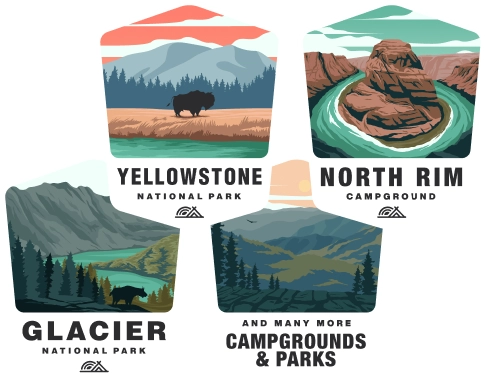Camping at Columbia River Gorge National Scenic Area
General Information
The Columbia River Gorge National Scenic Area encompasses an impressive natural canyon of the Columbia River as it cuts through the Cascade Range. It is situated along the border of Washington and Oregon states and is known for its spectacular scenery with cliffs, waterfalls, and a diverse array of plants and wildlife.
Camping
Permits and Reservations
Most campgrounds within the National Scenic Area may require a reservation, especially during peak season. Some campgrounds operate on a first-come, first-served basis. Make sure to check individual campgrounds for specific details. A Northwest Forest Pass or other valid recreation pass might be required for parking at certain trailheads within the scenic area.
Campground Amenities
Amenities vary greatly among different campgrounds from primitive sites with minimal facilities to those with full electric and water hookups. Common amenities include picnic tables, fire pits, potable water, and restrooms.
Types of Camping
- Developed Campgrounds: These have designated campsites, and usually have facilities like bathrooms and running water.
- Dispersed Camping: Outside of designated campgrounds, dispersed camping is allowed in certain areas but comes with more stringent rules to protect the environment, such as packing out all waste.
- Backcountry Camping: For those seeking a wilderness experience, backcountry camping is an option. Always ensure to follow Leave No Trace principles and obtain any necessary permits.
Activities
Hiking and Trails
The area offers an extensive network of trails varying in difficulty, from easy walks to challenging backcountry hikes.
Water Recreation
With the Columbia River and numerous other water bodies, activities like fishing, boating, and windsurfing are popular.
Sightseeing
Visitors can enjoy views of iconic spots such as Multnomah Falls, the Gorge's many other waterfalls, and scenic outlooks.
Wildlife and Plants
The diverse climates within the Gorge have created habitats for a wide variety of plant and animal life. Birdwatching is particularly rewarding, and you might encounter species such as bald eagles and ospreys along the river.
Safety and Regulations
Fire Safety
Fire restrictions may be in effect, especially during dry, hot summers. Always comply with fire bans and use established fire rings in campgrounds.
Weather
Weather in the Gorge can be unpredictable; it's often windy and can change rapidly. Always prepare for a range of conditions, especially when hiking or engaging in water activities.
Leave No Trace
Adhere to Leave No Trace principles to maintain the environment for future visitors. This includes packing out all trash and minimizing impact on the natural surroundings.
Pets
Pets are often allowed in campgrounds and on trails but must be kept on a leash and under control. Some areas may have restrictions, so check before you go.
Protecting the Landscape
Stick to designated trails and respect wildlife. Collecting plants, rocks, and cultural artifacts is prohibited.
Conclusion
Camping in the Columbia River Gorge National Scenic Area offers a chance to immerse oneself in the unparalleled beauty of the Pacific Northwest. Whether you seek a family-friendly camping experience or a solitary trek in the wilderness, the Gorge can cater to a range of outdoor enthusiasts. Always plan ahead, be mindful of the regulations, and respect the natural habitat to ensure a safe and enjoyable visit.

